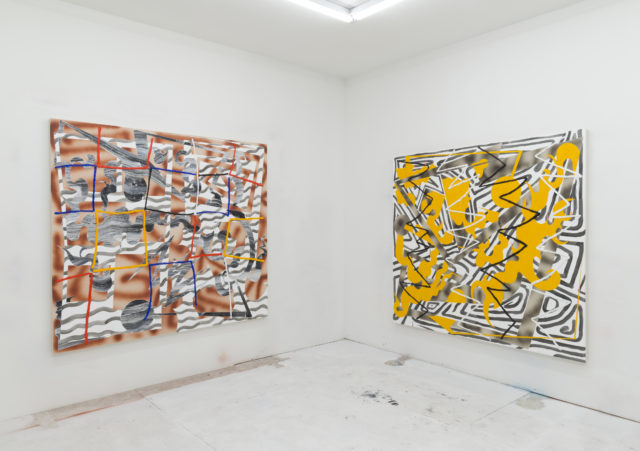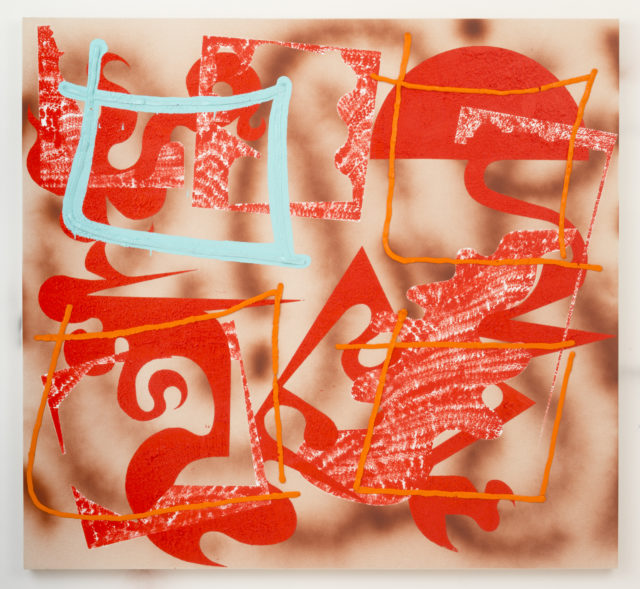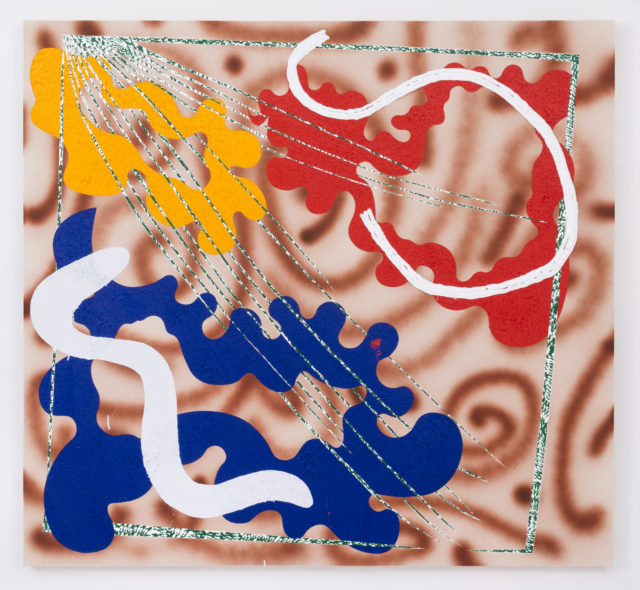
Trudy Benson, installation view
Trudy Benson is a force to be reckoned with. Her painting upon painting upon painting leave artists and casual observers alike gazing in wonderment at the layers in her work. Her best abstractions demonstrate a masterful handling of patterning and color and seem to vibrate on the wall.
This week, I sat down with New York based painter, Trudy Benson on the occasion of her two concurrent solo shows at Ribordy Contemporary in Geneva and Galerie Bernard Ceysson in Paris, both opening at the end of March. We nerded out. We discussed the influence of experimental film on her newest body of work, as well as the evolution of her richly painted, lyrical oils.
Irena Jurek: Tell me about the shift away from digital influences in your paintings recently. Has your interest in experimental film and more specifically the films of Robert Breer played a role in how your paintings have evolved?
Trudy Benson: My paintings have shifted from the content being heavily digitally influenced to me thinking more about analog ways of making work and collage. I’ve been thinking about the spray paint as a surface noise, which also references old films and photography. The idea of sequencing has also entered my work as a result. There’s a specific Robert Breer film, A Man and His Dog Out for Air, that’s this beautiful stop animation with line drawings that especially resonated with me. Things transform into other things, and they go from abstract to representational. The energy and sense of fluidity really resonated with me.
IJ: I can definitely see a relationship between Breer and your work, especially in the spontaneity and the sense of improvisation.
TB: Definitely, that’s also true in the process, because I work intuitively, and I never know how things will turn out in the end.
IJ: There’s a record of time that exists within your paintings, which also relates to film, because it’s a time-based medium.
TB: Yes, there’s a sequence from the back forward, and there’s also a shallow depth that happens because of the spray paint against the impasto paint, which feels like something is moving across a plane. The diffused sprayed layers don’t feel like a specific picture plane, instead they are a space where parts of the painting can act or perform.

Trudy Benson, “Flame in Cave”, 2016, 61 x 66 inches
IJ: There is definitely that sense of theatricality in your work. So you see them as having a representational element, too?
TB: Yes, I do. The one we’re looking at, this red one, I was thinking about Matisse cut outs and also about making paper collages when I was younger. In a way it’s representative of other ways of making imagery, actual representational elements are present, too. I’ve even made a series of paintings about fire.
IJ: The experience of engaging the senses and being alive in the world seems so vital to your work. Before you were talking about the sensation of sound, and now you mentioned your fire series, which actually seem to give off heat, it’s intriguing how you’re creating this synesthetic experience through paint.
TB: You know, my work in the past had been so invested in digital media as a reference. It was an interesting enough idea for me to make many paintings in this series, but one of the many limitations was that in any discussion about the work, the physical act of painting seemed to fall by the wayside. This is heartbreaking. One of the reasons I fell in love with painting was the sensation of walking into a room and being able to smell the paint. Surface is so important to me for the same reason, there is a physical presence that is immediately apparent when you are actually in a space with a painting. I also enjoy using colors and color combinations that can’t quite be photographed the same way that our eyes see the color IRL. It’s almost a fetish to have so many sensory qualities in an essentially 2-D object, especially these days when almost anything can be experienced virtually. The idea that a painting, which at one time was a virtual experience, a window, can now be decidedly phenomenal is something that has driven the work for years.
 Trudy Benson, “Trio”, 2017, 61 x 66 inches
Trudy Benson, “Trio”, 2017, 61 x 66 inches
IJ: The physicality of the paint itself becomes a subject, in how far you can push the confines of the medium itself.
TB: Drawing is really important to my process, too. That’s one of the reasons I continue to use the extruded paint, it becomes this prominent line that is harder to do with painting on a large scale. Those lines have a physical presence, and they feel like you can actually manipulate them or move them around.
IJ: There seems to be a desire for freedom in your work. Each painting is different from the next one.
TB: I feel like I’ve slowed down a lot, and have made more similar paintings recently. However, I’ve always wanted to make each painting completely different from the last one in the past. If I do repeat things in paintings, I don’t like to repeat them in the same way.


Comments on this entry are closed.
{ 2 trackbacks }